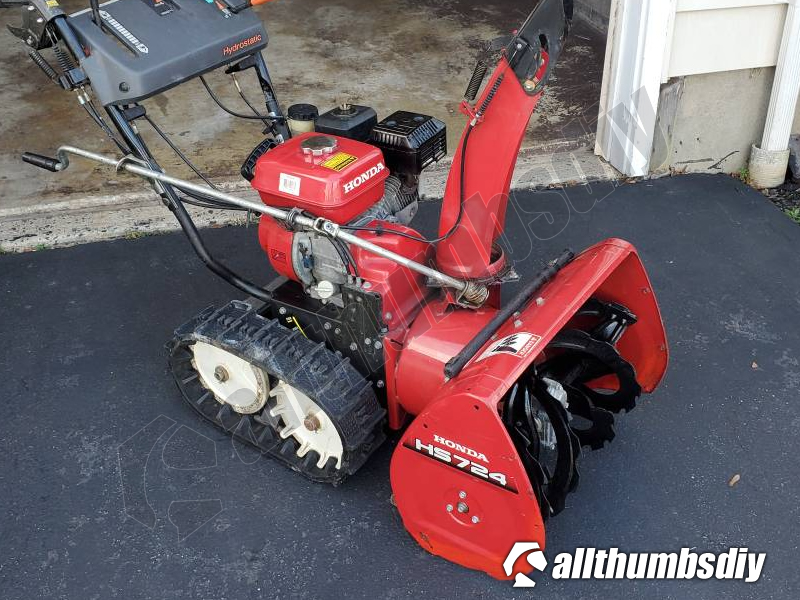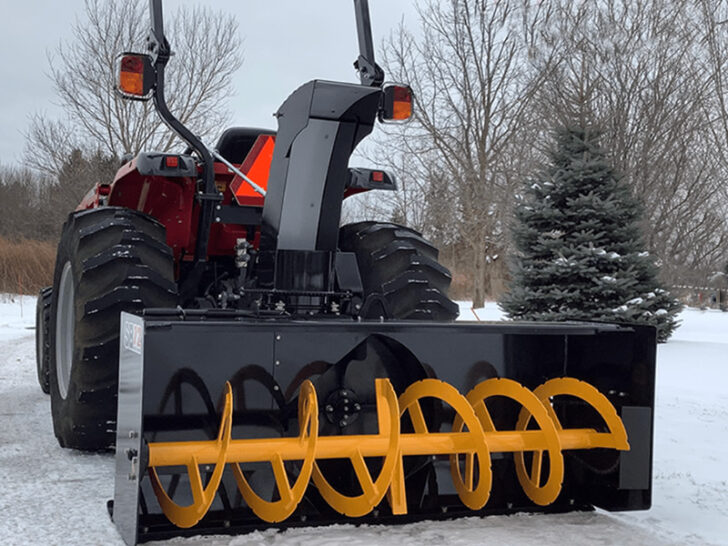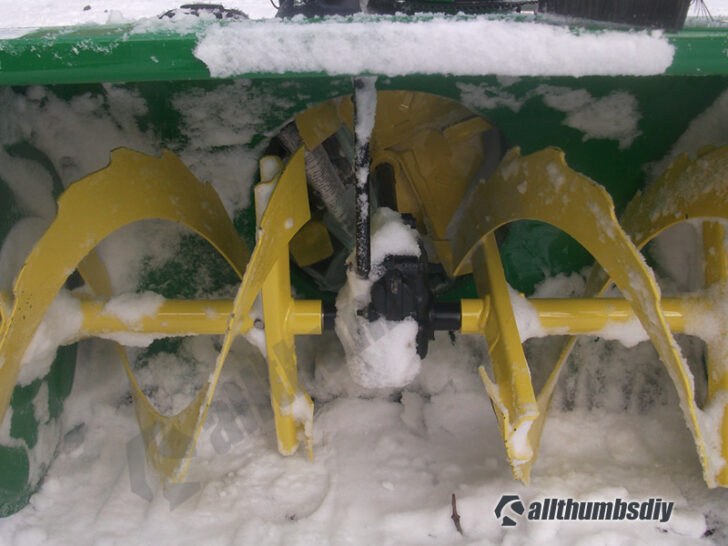Used snow blowers can be a smart choice if you are looking to find an efficient and cost-effective snow removal solution. Over the past two decades, the reliability of snow blowers has significantly improved, thanks to advancements in technology and design.
However, buying a pre-owned machine comes with its own set of considerations. This article dives into the reliability trends of snow blowers over the last 20 years and provides essential tips on what potential buyers should watch out for when selecting a used snow blower.
Table of Contents
- Table of Contents
- Introduction
- Is Buying a Used and Older Snow Blower Good Idea?
- Evaluating Engine Condition in Used Snow Blowers
- Inspecting the Auger Gearbox in Used Snow Blowers
- Assessing Rust
- Evaluating Skids
- Inspecting Auger Blades
- Evaluating Chute Cranks
- Comparing Handle bar controls
- Considering the Size and Features
- Evaluating Prior Use or Environment
- Wrapping Up
- Frequently Asked Questions
- You May Also Like
Introduction
Navigating the market for a used snow blower can be daunting, whether you’re scrolling through Craigslist looking for used snowblowers for sale, pondering over the right price for a second-hand model, or exploring refurbished options.
The Used Snow Blowers – Buying Guide is designed to simplify this process. It will not only answer key questions like “How much should I pay for a used snowblower?” or “Where to buy used snow blowers?” but also provide insights into the best selling models of the past.
Additionally, we’ll dig deep into telltale signs of equipment wear and tear so that you don’t get ripped off by an unscrupulous seller.

Whether you’re eyeing a bargain on Craigslist or considering a refurbished snow blower, this guide aims to equip you with all the necessary information to make a well-informed purchase.
Is Buying a Used and Older Snow Blower Good Idea?
Snow blowers from the late 2000s to the 2015s can be excellent finds, known for their robust construction. Brands like Honda, Ariens and Toro from this era are renowned for using high-quality, heavy metal in their build, along with durable paint, and parts for these models are generally still available.
These older machines, while not throwing snow as far as their modern counterparts, are still quite capable of clearing large areas effectively. Their heavier intake housings give them an advantage in tackling dense snow piles compared to newer, lighter models.
However, it’s important to note that these vintage machines may show signs of wear, and their engines might not perform as powerfully as when they were new. Yet, with adequate compression, they can still be nearly as efficient as newer models.

Many Honda, Ariens and Toro snow blowers from the 2000s, with engine power ranging from 5 to 10 horsepower, are capable of throwing snow 15 to 20 feet under average conditions, compared to 20 to 30 feet for newer models.
Newer snow blowers often feature taller chutes, which aid in directing the snow more effectively, offering a slight edge over the older models with shorter chutes.
If your snow-clearing needs aren’t overly demanding, an older snow blower can be a cost-effective solution. While they may rattle and shake more due to loose controls or fittings, simple maintenance like tightening bolts can mitigate much of this noise.
In terms of ergonomics, newer models tend to offer more user-friendly features, such as top-mounted dash controls for chute adjustment, compared to the side handle controls of older models.
This might not be a significant factor depending on your specific needs, especially if your snow clearing involves long, straight paths with minimal need for chute direction changes. However, for some, the convenience of top controls can be a significant advantage.
Evaluating Engine Condition in Used Snow Blowers
Assessing the engine condition is crucial when considering a used snow blower. Engine compression is vital for power and torque, essential for efficient snow clearing. However, determining compression is not straightforward and cannot be gauged by merely listening to the engine or pulling the starter rope.
Most engines are designed with a compression release mechanism to aid in starting, making it difficult to assess engine strength through these methods.
Methods to Assess Engine Health:
- Hand Turning for Compression Check: A rough assessment can be made by manually turning the motor in reverse to reach a compression stroke. If it springs back, this suggests acceptable compression. However, this test is often impractical as it requires removing the pull start or belt cover, and belt resistance may prevent hand turning.
- Compression Testing: This is a more informative method, although not entirely conclusive due to the compression release mechanism. A reading above 100 psi is generally positive, while anything below 45 psi is concerning. The range in between is ambiguous and doesn’t necessarily indicate poor engine health. The test involves pulling the rope through several compression cycles, or using the electric start, and observing the cumulative reading.
- Leakdown Testing: This advanced test involves introducing pressure through the spark plug hole and measuring air loss through cylinder rings, valves, and the head gasket. The air escaping can be detected through various parts of the engine, helping identify specific issues.
Engine Sound Misconceptions:
It’s important to note that a snow blower engine with internal problems, such as valve issues or worn rings, can still sound robust. Used machines naturally exhibit some wear and reduced compression, which might affect peak performance but not the overall functionality.
Practical Checks When Viewing a Snow Blower:
- Starting the Engine: It should start within three pulls using the rope, and the electric start should function smoothly.
- Smoke Emission: Look out for persistent white smoke (indicating oil burning) or black smoke (too much fuel). Temporary smoke on startup is normal but should clear quickly.
- Oil Leaks: Check for oil around the motor and any sputtering from the breather tube, which is a red flag.
- Engine Behavior: Minor hunting is not a major concern, especially if it subsides at full throttle.
- Test Drive: Operate the snow blower to check for excessive rattling or shaking.
Checking the Intake Housing and Impeller:
- Intake Housing: Expect scrapes and some rust inside due to rocks and gravel, especially in older, quality-built models like Ariens and Toro. Tap the bucket to check the metal integrity.
- Impeller: Paint loss and scratches are normal, as long as the metal is solid. Surface rust is common and not a major concern.
These checks and considerations are vital in assessing the condition and reliability of a used snow blower.
Inspecting the Auger Gearbox in Used Snow Blowers
The auger gearbox is a pivotal component in a snow blower, responsible for transferring power from the impeller drive to the auger blade axle. Inside this gearbox are crucial gears, typically a worm drive and a helical gear.
While it’s not feasible to fully assess the condition of the auger gearbox without disassembling it, you can still get a general idea through a simple manual check.
How to Check Auger Gearbox:
- Impeller and Auger Blade Movement Test: Reach into the chute and manually push the impeller in one direction while simultaneously holding an auger blade with your other hand. You should be able to feel the auger blade move in response to the impeller’s movement. Repeat this by turning the impeller in the opposite direction, observing the auger blade’s movement again.
- Assessing Gear Slop: By moving the impeller back and forth, you can gauge the amount of slop, or play, in the gears. Some slop is normal and expected in the gearbox, but it should generally not exceed an eighth of a turn on the impeller. Be wary of snow blowers where the impeller needs to be turned more than half a turn before the blades respond. While less than half a turn might be acceptable, it becomes a subjective judgment based on the specific machine and the feel of the gears.
- Degree of Concern: If you notice that the slop is particularly free and falls between a quarter to a half turn, it should be a point of concern.

This manual test offers a practical way to evaluate the integrity of the auger gearbox without needing to open it up.
A snow blower with an excessively loose auger gearbox may require costly repairs, so it’s crucial to perform this check before making a purchase decision on a used machine.
Assessing Rust
Rust is a common occurrence in older snow blowers, but it’s not always a deal-breaker. The key factor to consider is whether the rust has compromised the structural integrity of the machine.
Augers and scraper blades, being in constant contact with rocks and debris, are prone to scratches that can lead to rust on the auger blades, intake housing, and impeller, as well as their respective housings.
Over time, paint will wear off, leading to rusting. However, it’s not uncommon to find quality machines that exhibit bare, shiny metal surfaces free of rust.
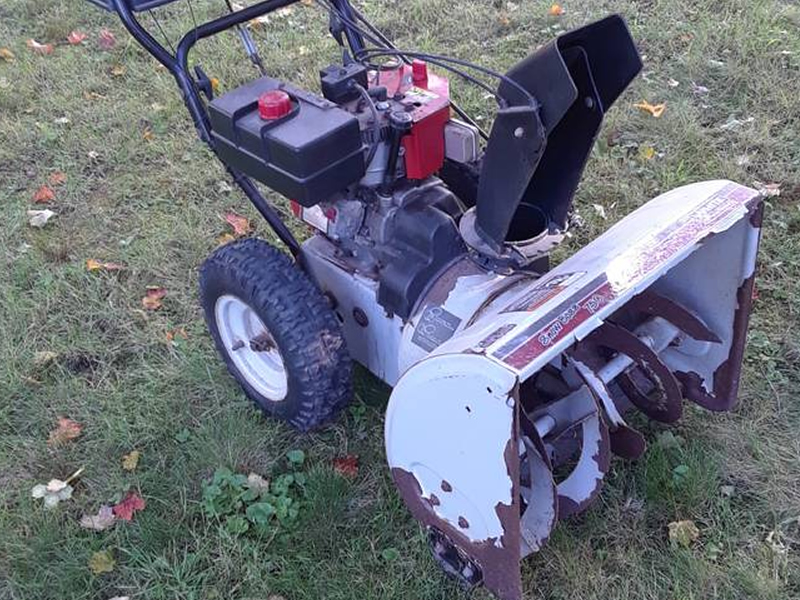
Steps to Evaluate Rust Impact:
- Physical Inspection: Look for visible signs of rust, especially on parts that are prone to wear and tear.
- Strength Test: Gently tap or bang on rusted areas of the snow blower. This can help you determine if the metal has been significantly weakened by rust. A hollow or flimsy sound can indicate serious rust damage, whereas a solid sound typically means the metal is still strong.
- Rust Treatment Potential: Consider the possibility of treating the rust. Rust can often be neutralized using rust inhibitors. After treating the rust, applying a coat of rust-inhibiting paint like Rustoleum can prevent further corrosion.
While rust is expected in older snow blowers, it’s important to assess its severity. If the rust has not substantially weakened the metal, the snow blower may still be a viable option, especially if you’re willing to invest some effort in rust treatment and prevention.
Checking for rust is crucial to ensure you’re investing in a machine that will remain durable and functional.
Evaluating Skids
Skids, often referred to as the “shoes” of a snow blower, are critical components attached to the lower sides of the intake housing.
Skids play a vital role as the main contact points that support the front of the machine, allowing it to glide over the snow. These parts are designed to be replaceable, as they bear the bulk of the machine’s weight and are subject to wear over time.
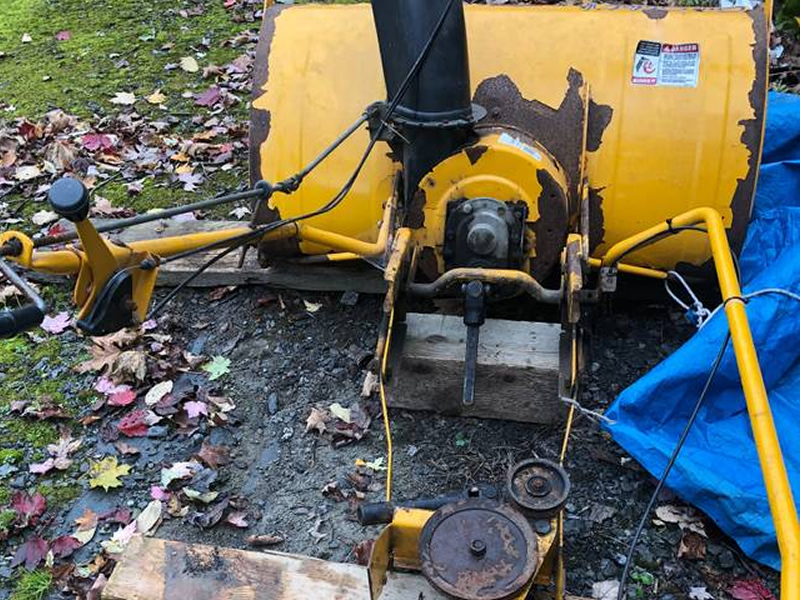
Key Points in Assessing Skids:
- Wear and Replacement: Check the condition of the skids. If they are significantly worn, it indicates that they have served their purpose of protecting other parts of the machine but now need replacement.
- Impact of Worn Skids: Overly worn or completely eroded skids can lead to the front of the machine resting on the scraper blade or auger blades. While the scraper blade is replaceable and robust enough to handle some wear, the auger blades are not designed for direct ground contact.
- Consequences of Auger Blade Contact: If the auger blades scrape the ground, it may not be immediately obvious due to the machine’s vibrations. However, this contact can create significant resistance, putting undue stress on the auger drive gearbox and leading to premature wear of its internal gears. Gearbox repairs can be costly, often leading owners to discard the snow blower.
- Warning Signs: Inspect the skids and feel the auger blade tips. If the tips have right-angle burrs sharp enough to cut fingers, it’s a clear sign of excessive wear due to ground contact. Such wear on the auger blades is a strong indicator to avoid purchasing that particular machine.

So, when considering a used snow blower, thoroughly inspect the condition of the skids and the auger blades for any signs of excessive wear. Choosing a machine with well-maintained or recently replaced skids can save you from costly repairs and extend the life of the snow blower.
Inspecting Auger Blades
When assessing the condition of auger blades on a second-hand snow blower, it’s common and generally acceptable to find rust spots. These rust areas often cause the paint to bubble up, but this is not necessarily a cause for concern.
The critical factor to consider is the condition of the metal beneath the rust. Typically, the integrity of the metal is maintained, rendering the rust as a superficial issue rather than a structural one.
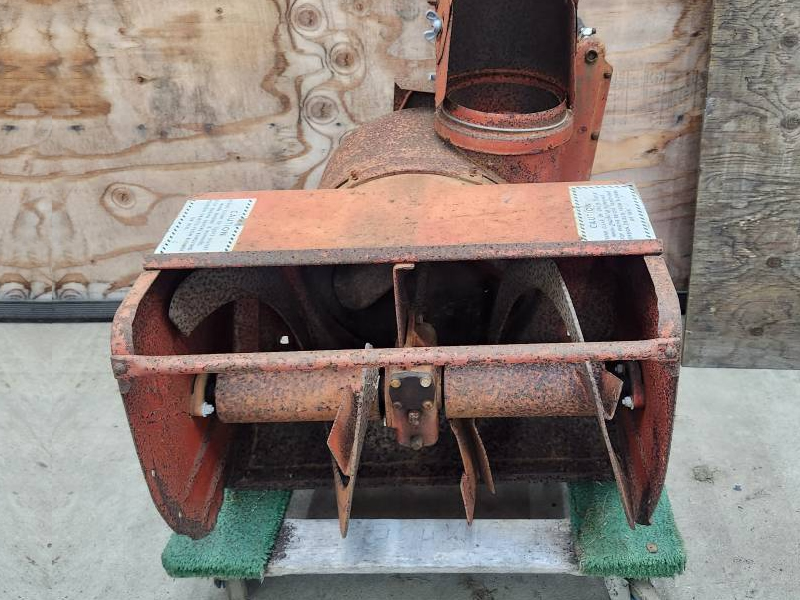
Key Considerations for Auger Blades:
- Rust and Paint Condition: Rust spots and bubbling paint are normal due to exposure to moisture and use. As long as the underlying metal is solid and not severely weakened, the auger blades are likely still functional.
- Blade Edge Wear: Pay close attention to the edges of the blades. If the leading edges are curled or bent, it indicates that the blades have made direct contact with the ground. This is a more serious concern as it suggests improper use or worn-out skids.
- Potential Gearbox Stress: Direct ground contact by the auger blades can create significant back pressure on the auger gearbox (as detailed in the section on auger gearboxes). This can lead to accelerated wear and potential failure of the gearbox, which is a costly issue to rectify.
While surface rust and paint deterioration on auger blades of a used snow blower are typically non-issues, it is crucial to examine the physical condition of the blades themselves.
Curled or damaged edges can be indicative of more serious underlying problems, potentially leading to expensive repairs. Therefore, a thorough inspection of the auger blades is essential in evaluating the overall health and value of a used snow blower.
Evaluating Chute Cranks
The position and design of chute cranks are key features to consider when purchasing a used snow blower. Typically, older models have their chute cranks located under the handlebars and to the side.
While this design is functional, it may not offer the same level of convenience as the dash-mounted cranks found on newer machines.

Key Differences in Chute Crank Designs:
- Location and Convenience: The placement of the chute crank can impact ease of use, especially in scenarios requiring frequent adjustments. Dash-mounted cranks, prevalent in newer models, are generally more accessible and easier to operate while clearing snow.
- Older Models with Dash Cranks: It’s noteworthy that some older models, often from higher-end brands like Ariens, Bolens, Snapper, and Jacobson, also feature dash-mounted cranks. These models are usually indicative of better overall quality and user-focused design.
- Personal Preference and Usage Needs: The choice between side-mounted and dash-mounted cranks may come down to personal preference and the specific demands of your snow-clearing area. For environments where constant chute adjustment is necessary, a dash-mounted crank can be a significant convenience.
When assessing a used snow blower, take note of the chute crank’s position and consider how it aligns with your usability preferences and the specific requirements of your snow-clearing tasks.
While not a deal-breaker, the convenience of a dash-mounted crank can enhance the overall user experience, especially in models known for their quality and durability.
Comparing Handle bar controls
The design of handle bar controls is a significant aspect that differentiates older snow blowers from newer models.
A notable advancement in newer machines is the integration of a latching mechanism that allows the auger clutch lever to lock with the drive lever.
This feature is particularly beneficial as it keeps the auger blades engaged while freeing up one hand to adjust the chute control.
Key Points on Handle Bar Controls:
- Auger and Drive Lever Latching: This latching mechanism is a convenience feature in newer models. It enables continuous operation of the auger while allowing for chute adjustments on the go. Without this feature, found in many older machines, you would need to disengage the auger drive lever to adjust the chute, halting snow throwing temporarily.
- Impact on Snow Clearing: The absence of this feature may not be a significant issue for small snowfalls. However, in heavy snow conditions, it can be inconvenient as you would need to stop to adjust the chute direction, disrupting the snow clearing process.
- Area-Specific Considerations: The usefulness of the latching control depends on your specific clearing area. In some cases, it may not be essential, and a brief pause to adjust the chute might not impact overall efficiency.
- Balancing Features and Utility: Like any feature, the importance of a latching control for the auger and drive levers should be weighed against its practicality for your needs. Considering the frequency and conditions of your snow clearing tasks, the absence of this feature might not significantly affect your overall experience.
When examining used snow blowers, consider how the design of the handle bar controls, especially the auger and drive lever mechanisms, aligns with your snow clearing habits and preferences.
While newer models with latching controls offer added convenience, older models without this feature can still be effective, depending on the specific requirements of your snow-clearing tasks.
Considering the Size and Features
When selecting a used snow blower, it’s important to reflect on your total usage per season. Typically, snow blowers are used only a few times each season, which can influence the necessity of certain features and the size of the machine.
Opting for a smaller snow blower that may lack advanced features like auger clutch locking, a differential, or hand warmers might not significantly impact your overall experience, especially if your usage is infrequent.
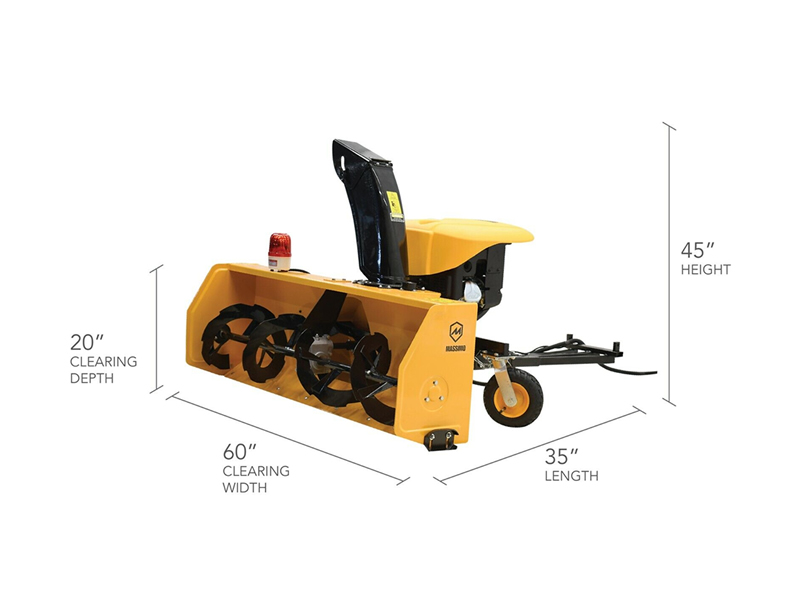
Factors to Consider in Size and Features:
- Frequency of Use: Given that snow blowers are generally not used extensively throughout the season, managing with a smaller, less feature-rich model can be a practical choice.
- Trade-offs: While a smaller snow blower or one without certain conveniences might take longer to clear snow or be slightly less comfortable, it still provides the significant benefit of not having to shovel manually.
- Subjectivity of Features: The importance of various features is highly subjective and depends on personal preferences and requirements. What might be essential for one person could be non-essential for another.
- Geographical Considerations: Your location plays a crucial role in determining the necessary features. For instance, in areas with heavy snowfall like Canada or the Great Lakes’ lake effect zones, having a fully-featured snow blower can be extremely beneficial. In contrast, in regions with less severe winters, like Eastern Massachusetts, these features might not be as critical.
When evaluating used snow blowers, it’s essential to balance the size and features of the machine with your specific needs, frequency of use, and local weather conditions.
While additional features can enhance convenience and efficiency, a basic model can still be sufficient for areas with lighter snowfall, making it a viable and economical choice.
Evaluating Prior Use or Environment
When considering a used snow blower, understanding its history of use is crucial. Key factors include the size of the previous owner’s driveway and the duration of ownership.
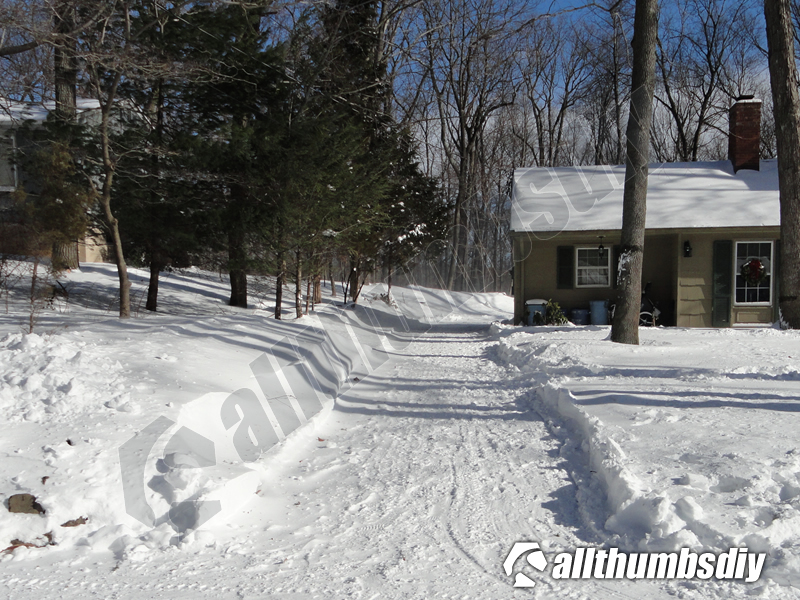
These details can give you a good sense of how extensively the snow blower has been used.
Evaluating Usage History:
- Driveway Size and Ownership Duration: A smaller driveway or limited use by the previous owner often suggests less wear on the snow blower. A machine that’s been owned since new and consistently stored indoors is likely to be in better condition.
- Condition Expectations: Snow blowers that have been lightly used and well-maintained often retain good engine compression and overall excellent shape. In many cases, these older, well-kept machines can outlast newer ones in terms of durability and performance.
- Regional Use Considerations: The geographical location where the snow blower was used also plays a significant role. For instance, a 10-year-old snow blower from a less snow-intensive area, like Quincy in Massachusetts, is likely to have seen less use compared to one of the same age from southern New Hampshire, where snowfall is heavier.
Understanding the previous usage of a snow blower can be a strong indicator of its current condition and potential longevity.
A machine with a history of light use and proper storage is often a great find, offering the reliability of a new snow blower at a fraction of the cost.
When evaluating used snow blowers, consider these aspects to gauge the value and expected performance of the machine.
Wrapping Up
In conclusion, when navigating the market for a used snow blower, a comprehensive approach encompassing various aspects is essential. Assessing the engine for proper compression, checking the auger gearbox for excessive play, and evaluating the condition of skids and auger blades for wear are fundamental steps.
The presence of rust, while common, should be scrutinized to ensure it hasn’t compromised the machine’s integrity. The design and location of chute cranks, as well as the ergonomics of handle bar controls, play a role in user convenience, particularly in models with advanced features.
The size and specific features of the snow blower should align with your typical usage and geographical needs, keeping in mind that for less frequent use, a simpler, smaller model may suffice.
Additionally, understanding the snow blower’s history, including the previous owner’s usage patterns and storage practices, can provide valuable insights into its current condition and potential longevity.
By thoroughly examining these aspects, you can make an informed decision, balancing cost with functionality, to find a used snow blower that meets your snow-clearing needs effectively and reliably. Remember, a well-maintained older model can often rival the performance of newer ones, offering a cost-effective solution for tackling winter’s challenges.
Frequently Asked Questions
- Is there a popular brand of snowblower I should get?
- Honda, known for its long-lasting build quality, is a great choice if found in optimal condition (used one will still be expensive). Additionally, Ariens and Briggs & Stratton are also reliable options worth considering for their consistent performance and quality.
- When should I try to buy a used snowblower?
- Spring can be a good time to search, as owners may reconsider their need for a snowblower after a mild winter or due to storage constraints. Early fall, is another opportune time. This is when many people upgrade their equipment and sell their old models, leading to an increase in ads, especially in November/December.
- Where can you buy a used snowthrower?
- Your local Craigslist, Facebook Market Place, or eBay (local delivery)

